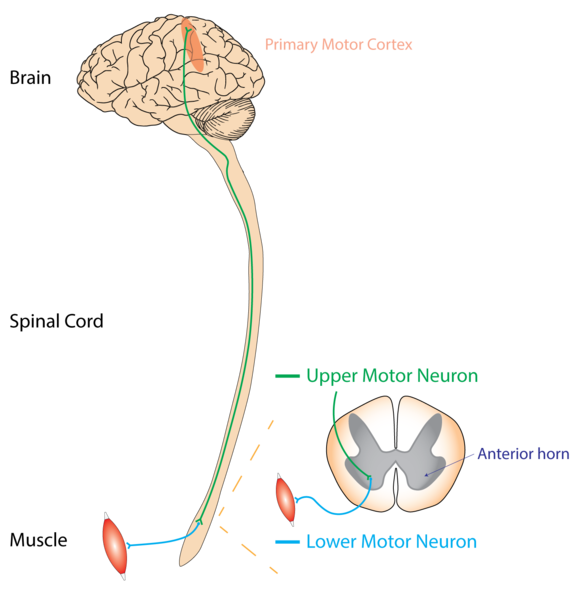Motor Neuron Diseases
Motor neuron diseases (MNDs) are a group of rare neurodegenerative disorders that selectively affect motor neurons, the cells controlling voluntary muscles.
Examples of MNDs include amyotrophic lateral sclerosis (ALS), progressive bulbar palsy (PBP), pseudobulbar palsy, progressive muscular atrophy (PMA), primary lateral sclerosis (PLS), spinal muscular atrophy (SMA), and monomelic amyotrophy (MMA).
These diseases can affect both children and adults, causing movement-related symptoms, primarily muscle weakness. While the exact causes of most MNDs are unknown, some forms are inherited. Research into these inherited forms has identified genes such as SOD1, which are very important in understanding the disease mechanisms.

Signs and Symptoms

Symptoms of MNDs vary depending on the specific disease but typically include a range of movement-related symptoms that develop slowly and worsen over time. Muscle weakness is a common feature, and muscle cramps and spasms may also occur.
Breathing difficulties can arise, such as exertional or orthopneic dyspnea, and respiratory failure may ensue if breathing muscles are affected. Bulbar symptoms like dysarthria, dysphagia, and sialorrhea can also be present.
Sensory functions usually remain unaffected. Emotional disturbances and cognitive changes, such as problems with word fluency, decision-making, and memory, are also observed.
MNDs can present with lower motor neuron (LMN) findings like muscle atrophy and fasciculations, upper motor neuron (UMN) findings like hyperreflexia, spasticity, and abnormal reflexes, or a combination of both. For instance, pure UMN diseases include PLS, while pure LMN diseases include PMA.
Patterns of Weakness
Patterns of muscle weakness in MNDs can be asymmetric or symmetric and may affect distal or proximal body parts. Three main weakness patterns are:
- Asymmetric distal weakness without sensory loss (e.g., ALS, PLS, PMA, MMA)
- Symmetric weakness without sensory loss (e.g., PMA, PLS)
- Symmetric focal midline proximal weakness (e.g., ALS, PBP, PLS)
Causes
Most MND cases are sporadic with unknown causes, though environmental, toxic, viral, or genetic factors may be involved. DNA damage, particularly involving TAR DNA-binding protein 43 (TDP-43), plays a very important role in MND pathogenesis. TDP-43 is essential for DNA repair, and about 95% of ALS patients exhibit abnormalities in its nuclear-cytoplasmic localisation, leading to significant DNA damage in motor neurons.
Diagnosis

Diagnosing MNDs can be challenging due to overlapping symptoms among different disorders. Diagnosis often relies on clinical findings, family history, and various tests to rule out disease mimics. Tests include cerebrospinal fluid (CSF) analysis, MRI, electromyogram (EMG), nerve conduction study (NCS), and occasionally tissue biopsy.
Treatment
Currently, there are no curative treatments for most motor neuron disorders. Care is primarily symptomatic and supportive, tailored to individual needs.
Prognosis
The prognosis of MNDs varies with the specific type. For instance, ALS has a median survival time of 2–5 years, while PLS patients may live 8–10 years. PMA and PBP have shorter survival times, whereas pseudobulbar palsy does not significantly alter life expectancy.
| Type | Median survival time from start of symptoms |
|---|---|
| Amyotrophic lateral sclerosis (ALS) | 2–5 years |
| Primary lateral sclerosis (PLS) | 8–10 years |
| Progressive muscular atrophy (PMA) | 2–4 years |
| Progressive bulbar palsy (PBP) | 6 months – 3 years |
| Pseudobulbar palsy | No change in survival |
Terminology
In the UK and Australia, the term motor neuron(e) disease commonly refers to ALS, while in the US and Canada, it encompasses a broader group of disorders. Although MND refers to specific diseases, other motor neuron disorders like spinal muscular atrophies are not classified as MNDs by the ICD-11.
Self-assessment MCQs (single best answer)
Which of the following is NOT typically classified as a motor neuron disease?
Which gene has been identified as very important in understanding the mechanisms of some inherited forms of motor neuron diseases?
Which of the following is a common symptom in motor neuron diseases?
Which of the following motor neuron diseases is characterised by pure upper motor neuron findings?
What is the median survival time from the start of symptoms for patients with Amyotrophic lateral sclerosis (ALS)?
Which protein is associated with significant DNA damage in motor neurons due to abnormalities in its nuclear-cytoplasmic localisation in ALS patients?
Which diagnostic test is NOT typically used to help diagnose motor neuron diseases?
Which of the following motor neuron diseases has a median survival time of 8–10 years from the start of symptoms?
What is the primary focus of treatment for most motor neuron diseases?
In which regions is the term "motor neuron(e) disease" commonly used to refer specifically to ALS?
Dentaljuce
Dentaljuce provides Enhanced Continuing Professional Development (CPD) with GDC-approved Certificates for dental professionals worldwide.
Founded in 2009 by the award-winning Masters team from the School of Dentistry at the University of Birmingham, Dentaljuce has established itself as the leading platform for online CPD.
With over 100 high-quality online courses available for a single annual membership fee, Dentaljuce offers comprehensive e-learning designed for busy dental professionals.
The courses cover a complete range of topics, from clinical skills to patient communication, and are suitable for dentists, nurses, hygienists, therapists, students, and practice managers.
Dentaljuce features Dr. Aiden, a dentally trained AI-powered personal tutor available 24/7 to assist with queries and provide guidance through complex topics, enhancing the learning experience.
Check out our range of courses, or sign up now!


